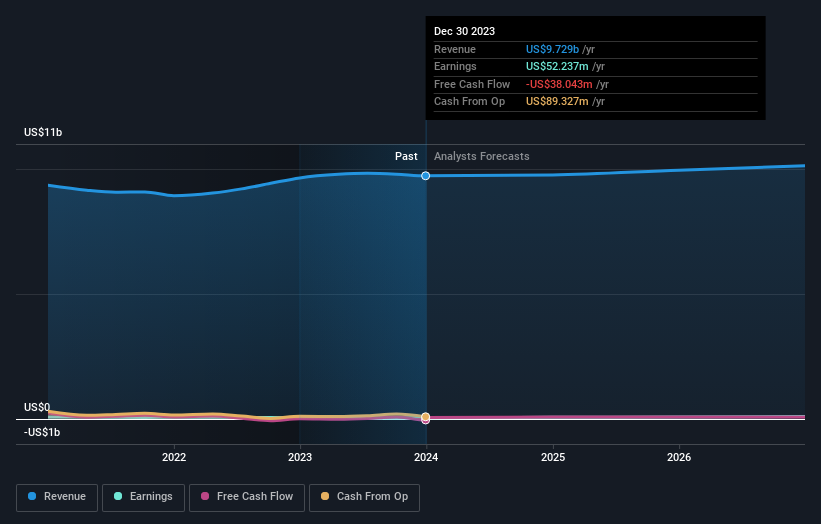SpartanNash Company Just Missed EPS By 17%: Here's What Analysts Think Will Happen Next
Shareholders might have noticed that SpartanNash Company (NASDAQ:SPTN) filed its full-year result this time last week. The early response was not positive, with shares down 6.5% to US$20.71 in the past week. Revenues were in line with forecasts, at US$9.7b, although statutory earnings per share came in 17% below what the analysts expected, at US$1.50 per share. The analysts typically update their forecasts at each earnings report, and we can judge from their estimates whether their view of the company has changed or if there are any new concerns to be aware of. Readers will be glad to know we've aggregated the latest statutory forecasts to see whether the analysts have changed their mind on SpartanNash after the latest results.
Check out our latest analysis for SpartanNash
Taking into account the latest results, SpartanNash's four analysts currently expect revenues in 2024 to be US$9.76b, approximately in line with the last 12 months. Statutory earnings per share are predicted to shoot up 29% to US$1.95. Before this earnings report, the analysts had been forecasting revenues of US$9.88b and earnings per share (EPS) of US$2.35 in 2024. So there's definitely been a decline in sentiment after the latest results, noting the real cut to new EPS forecasts.
The average price target fell 7.1% to US$24.33, with reduced earnings forecasts clearly tied to a lower valuation estimate. That's not the only conclusion we can draw from this data however, as some investors also like to consider the spread in estimates when evaluating analyst price targets. The most optimistic SpartanNash analyst has a price target of US$28.00 per share, while the most pessimistic values it at US$22.00. Still, with such a tight range of estimates, it suggeststhe analysts have a pretty good idea of what they think the company is worth.
Of course, another way to look at these forecasts is to place them into context against the industry itself. We would highlight that SpartanNash's revenue growth is expected to slow, with the forecast 0.3% annualised growth rate until the end of 2024 being well below the historical 3.5% p.a. growth over the last five years. Compare this against other companies (with analyst forecasts) in the industry, which are in aggregate expected to see revenue growth of 4.4% annually. So it's pretty clear that, while revenue growth is expected to slow down, the wider industry is also expected to grow faster than SpartanNash.
The Bottom Line
The biggest concern is that the analysts reduced their earnings per share estimates, suggesting business headwinds could lay ahead for SpartanNash. Fortunately, the analysts also reconfirmed their revenue estimates, suggesting that it's tracking in line with expectations. Although our data does suggest that SpartanNash's revenue is expected to perform worse than the wider industry. The consensus price target fell measurably, with the analysts seemingly not reassured by the latest results, leading to a lower estimate of SpartanNash's future valuation.
Following on from that line of thought, we think that the long-term prospects of the business are much more relevant than next year's earnings. We have forecasts for SpartanNash going out to 2026, and you can see them free on our platform here.
You should always think about risks though. Case in point, we've spotted 2 warning signs for SpartanNash you should be aware of, and 1 of them is a bit unpleasant.
Have feedback on this article? Concerned about the content? Get in touch with us directly. Alternatively, email editorial-team (at) simplywallst.com.
This article by Simply Wall St is general in nature. We provide commentary based on historical data and analyst forecasts only using an unbiased methodology and our articles are not intended to be financial advice. It does not constitute a recommendation to buy or sell any stock, and does not take account of your objectives, or your financial situation. We aim to bring you long-term focused analysis driven by fundamental data. Note that our analysis may not factor in the latest price-sensitive company announcements or qualitative material. Simply Wall St has no position in any stocks mentioned.

